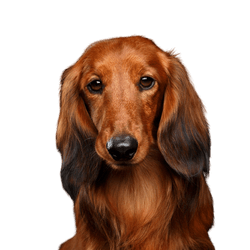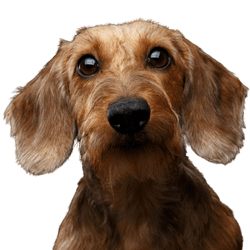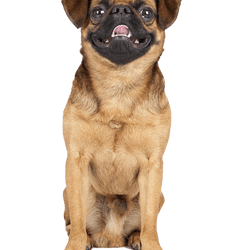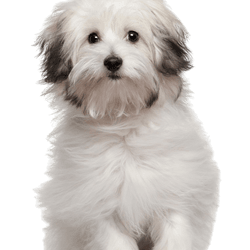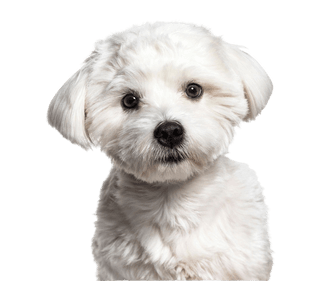
Maltese Breed description: Character & Co
Maltese
Facts & Origin
Where does the Maltese originate
This dog breed is recognised by the FCI and belongs to the FCI Group 9 (companion and companion dogs), Section 1.1 (Bichons), Standard No. 65 without working test. The descent of the small white dogs is not quite clear. If you believe the traditions, the Maltese belongs to one of the oldest dog breeds. Probably Phoenician sailors and merchants spread the original form of this breed from Egypt to the large region around the Mediterranean Sea already 2,000 years ago. This assumption is supported by the discovery of small statuettes of these dogs that were found in the tomb of Pharaoh Ramses II. The statuettes are said to look very similar to the Maltese of today. In any case, it is certain that the name cannot be traced back to the island of Malta, although Phoenician sailors are said to have discovered similar dogs there in 1,500 BC. In the 15th and 16th century these dogs finally started their triumphal procession into the world. They were extremely popular in noble circles at that time. Famous lovers of this breed of dogs were the British Queen Victoria and the French Queen Marie Antoinette. Also in the today's time the small animals have lost nothing of their popularity. Stars like Marilyn Monroe and Elvis Presley owned a Maltese.




| Alternate Name | - |
| Origin | Malta |
| Life expectancy | 12 - 15 years |
| Care requirements | high-maintenance |
| Activity level | low |
| FCI group | Bichons and related breeds |
| AKC group | Toy Group |
| KC group | Toy Group |
Maltese mixes
Attitude, character and temperament of the breed
Breed characteristics of the Maltese Dog
Typical characteristics of the Maltese are
- spirited
- vigilant
- intelligent
- eager and to learn
- cuddly
- playful
Maltese have a strong urge to move, which you should satisfy. Otherwise, your dog can quickly become a yapping annoyance, which might also live out excess energy on your home furniture.
Attitude and education
The Maltese is easy to handle and therefore also suitable for first-time dog owners. Well-behaved, they make for an ideal family dog which also gets along well with children. If you ignore the need for early and consequent training of your Maltese puppy though, you might have to deal with an aggressive and naughty specimen of this breed as a result. However, with the right upbringing and training, possibly with the help of attending a dog school, you will end up with a cuddly and affectionate dog who will build a close relationship with you. Early socialisation or habituation to other people and animals is also advisable. What makes the Maltese stand out among other long-haired dog breeds is his odourless coat and the lack of coat change. This will please sensitive people or hygiene fanatics, because Maltese dogs have only shed very little. With a little luck you can also find a representative of this funky breed on the internet or in a shelter, because they might have been given away (owner passed away, given away because of allergies etc.).
Character
Usage





Health and breeding information
Care and health of a Maltese dog
Its care is not easy. Their dense long coat requires good grooming like daily brushing, otherwise it tends to mat easily. Also a bath with dog shampoo, at least once to twice a month, should not be missed. Make sure you always dry them off well, because the animals are very prone to suffering from colds. Maltese have an average life expectancy of 12 - 15 years. Although the Maltese is generally a rather robust and healthy dog breed, it can also suffer from health problems:
- Infections of the eyes: the long hairs of the Maltese coat hanging down the face often cause eye irritation with persistent lacrimation, reddened eyes and itching or acute to chronic conjunctivitis. But there are some measures you can take to prevent this as much as possible. The most important measure is to keep hairs away from their eyes. The easiest way to do this is to shorten their hair. Alternatively, you can also use hair clips. You should also check their eyes daily and clean them with a soft cloth and a special eye cleaner.
- Patella luxation: This is the painful jumping out of the patella. This is caused by genetically caused joint malpositions and weak ligaments. Preventive measures are the avoidance of overweight and a lot of exercise.
- Diseases of the skin: The dense coat of dogs gets dirty quickly, this causes itching, the dog scratches itself; the result can be skin injuries which can become inflamed. The best measure against this is a regular, yet quite demanding, coat care. Alternatively, the coat can be kept shorter, which reduces the care required. To do this, have their coat trimmed every 2 to 3 months at the dog groomers.
- Dental problems: Maltese often suffer from malpositioned teeth, tartar and premature tooth loss. Sometimes only a visit to the dog dentist can help. But you can prevent it by daily cleaning and checking their teeth, promoting self-cleaning (e.g. with chewing articles such as dried cowhide) and the right diet. A sugar-free and largely starch-free diet reduces the formation of tartar and bacterial plaque in your dog's mouth.
Typical Maltese hereditary diseases, such as
- vascular malformations,
- idiopathic cerebellitis (tremor) or
- White Shaker Syndrome (whole body trembling),
- Cushing's disease (disease of the adrenal glands) and hydrocephalus,
can now be successfully avoided by serious Maltese breeding. In Germany there are numerous breeders of this popular dog breed. It is best to buy your puppy from a breeder near you, this way you can keep an eye on them growing up from the beginning. A Maltese costs about 1000 Euro. But there are also countless Maltese and mixed breeds to be found in shelters. Inform yourself in advance and give a "second-hand" dog the chance to find a new home.


Appearance of the Maltese
Their long blossom-white fur, their round brown eyes and the small button nose make this dog a particularly cute representative of its kind. The coat colour can vary from bright white to ivory. Untrimmed it reaches down to the ground. The males reach a height of 21-25 cm, the bitches grow to 20-23 cm measured at the withers. The weight of the males is 3-4 kg, that of the females 3-4 kg.
| Fur length | medium |
| Fur | wavy |
| Ear shape | Triangle |
| Tail | fanned out |
| Anatomy | dainty |
| Size ♀ | 20 - 23 cm |
| Weight ♀ | 3 - 4 kg |
| Size ♂ | 21 - 25 cm |
| Weight ♂ | 3 - 4 kg |
| Suitable For | Beginner, Seniors |
Colors




Known Diseases
Eye diseases
Often occur with allergies and intolerances.
Skin inflammations
Can be hereditary in certain breeds.
Heart disease
Can occur frequently in dogs and can sometimes be treated with medication.
Patellar problems
Problems with the Patellar can be a displacement or weak kneecap, which is one of the most common causes of lameness in dogs, also because of overweight.
FAQ
-
A Maltese puppy needs similar equipment as other puppies: blanket, bowls, food, chest harness or collar, a brush for the curls and the coat in general.
-
A Maltese puppy costs about 1500 Euro.
-
On average, a Maltese needs 1-2 hours of outdoor exercise per day. You are welcome to buy smart toys and do additional mental exercise with him at home. Search games, for example, are ideal.
-
A Maltese dog needs about 2 years to be fully grown.
Sources and relevant links
Gabriele Lehari (2004). Ulmers Großes Lexikon der Hunderassen. Ulmer.
Offizielle Seite des FCI
Accessed on 25.01.2023
VDH.de
Accessed on 25.01.2023
Horst Hegewald-Kawich (2015). Hunderassen von A bis Z: Über 200 beliebte Rassen aus aller Welt. Gräfe und Unzer Verlag.
Other small dogs
Useful Articles
You can find articles that might interest you in the dogbible blog to match your favorite breed.
Visit our magazineto stay up to date on dog trends.
To find out more, view our Privacy Policy
Find here the breed that suits you and find out what character traits it has. Here you can also learn more about the origin, size and weight of your favorite breeds.
Matching your favorite breed, you'll find articles that might interest you on the dogbible dog blog.
Hip joint and elbow dysplasia in dogs
Roller skating or skateboarding with the dog
Tips for Mallorca holidays with dog - these hotels and places you should know
Going to the lake with your dog: Austrian dog beaches at the lake




